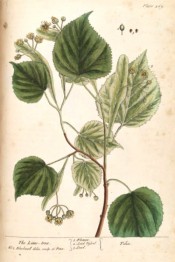Tilia x vulgaris Hill.
A hybrid, Tilia cordata Mill. x Tilia platyphyllos Scop. Fully hardy, broadly columnar tree with ovate leaves, to 20cm long, and pendant cymes of up to 15 yellow flowers in midsummer. To 14m. [RHSE, Hortus, Hilliers’].
Horticultural & Botanical History
The most commonly grown Lime in the past. ‘The French, growing tired of the horse-chestnut, as Du Hamel reports, adopted the tree for ornamental plantations in the time of Louis XIV. It generally composes the avenues about the French as well as the English gentry of this date.’ [Don]. ‘The Lime-Tree. Tilia. This grows to be a tall tree, the leaves are a bright grass green and the flowers yellowish. It is planted in parks & about Gentlemen’s Seats, flowering in June and July. The flowers are accounted cephalic and nervine, and good for the apoplexy, epilepsy, vertigo, and palpitation of the heart. They are used in the Aqua Peon. Comp. and the Spiritus Lavendulae. The Aqua Florum Tiliae takes its name from them.’ [Blackwell pl.469/1739].
History at Camden Park
Listed in all published catalogues [T.965/1843].
Notes
Published Mar 27, 2009 - 12:03 PM | Last updated Mar 29, 2010 - 03:15 PM
| Family | Tiliaceae |
|---|---|
| Category | |
| Region of origin | Europe |
| Synonyms | |
| Common Name | Common lime, Linden |
| Name in the Camden Park Record | Tilia Europaea - Common Lime or Linden tree |
| Confidence level | high |
